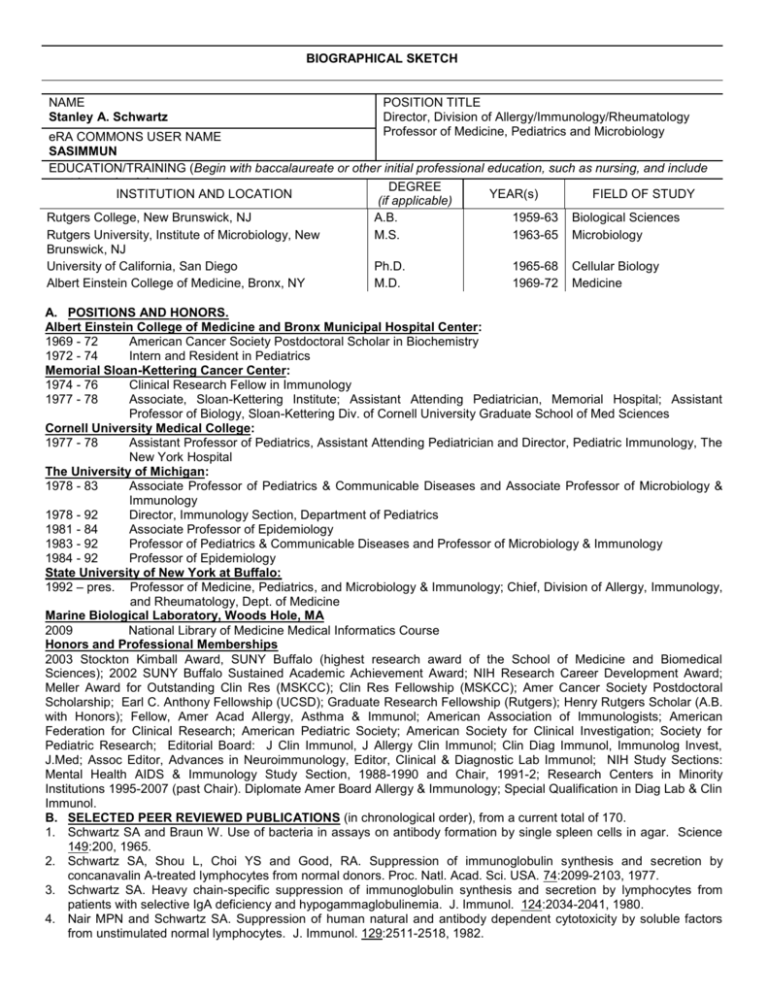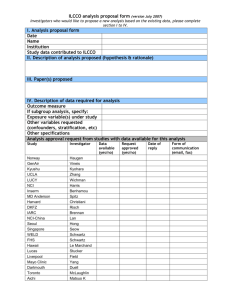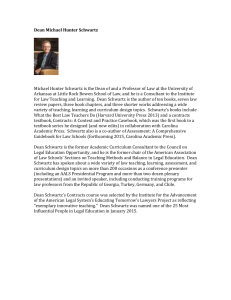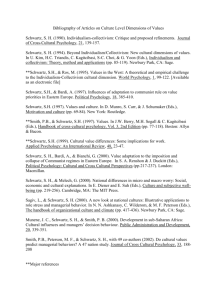Biography - University at Buffalo
advertisement

BIOGRAPHICAL SKETCH NAME Stanley A. Schwartz POSITION TITLE Director, Division of Allergy/Immunology/Rheumatology Professor of Medicine, Pediatrics and Microbiology eRA COMMONS USER NAME SASIMMUN EDUCATION/TRAINING (Begin with baccalaureate or other initial professional education, such as nursing, and include postdoctoral training.) DEGREE INSTITUTION AND LOCATION YEAR(s) FIELD OF STUDY (if applicable) Rutgers College, New Brunswick, NJ A.B. 1959-63 Biological Sciences Rutgers University, Institute of Microbiology, New M.S. 1963-65 Microbiology Brunswick, NJ University of California, San Diego Ph.D. 1965-68 Cellular Biology Albert Einstein College of Medicine, Bronx, NY M.D. 1969-72 Medicine A. POSITIONS AND HONORS. Albert Einstein College of Medicine and Bronx Municipal Hospital Center: 1969 - 72 American Cancer Society Postdoctoral Scholar in Biochemistry 1972 - 74 Intern and Resident in Pediatrics Memorial Sloan-Kettering Cancer Center: 1974 - 76 Clinical Research Fellow in Immunology 1977 - 78 Associate, Sloan-Kettering Institute; Assistant Attending Pediatrician, Memorial Hospital; Assistant Professor of Biology, Sloan-Kettering Div. of Cornell University Graduate School of Med Sciences Cornell University Medical College: 1977 - 78 Assistant Professor of Pediatrics, Assistant Attending Pediatrician and Director, Pediatric Immunology, The New York Hospital The University of Michigan: 1978 - 83 Associate Professor of Pediatrics & Communicable Diseases and Associate Professor of Microbiology & Immunology 1978 - 92 Director, Immunology Section, Department of Pediatrics 1981 - 84 Associate Professor of Epidemiology 1983 - 92 Professor of Pediatrics & Communicable Diseases and Professor of Microbiology & Immunology 1984 - 92 Professor of Epidemiology State University of New York at Buffalo: 1992 – pres. Professor of Medicine, Pediatrics, and Microbiology & Immunology; Chief, Division of Allergy, Immunology, and Rheumatology, Dept. of Medicine Marine Biological Laboratory, Woods Hole, MA 2009 National Library of Medicine Medical Informatics Course Honors and Professional Memberships 2003 Stockton Kimball Award, SUNY Buffalo (highest research award of the School of Medicine and Biomedical Sciences); 2002 SUNY Buffalo Sustained Academic Achievement Award; NIH Research Career Development Award; Meller Award for Outstanding Clin Res (MSKCC); Clin Res Fellowship (MSKCC); Amer Cancer Society Postdoctoral Scholarship; Earl C. Anthony Fellowship (UCSD); Graduate Research Fellowship (Rutgers); Henry Rutgers Scholar (A.B. with Honors); Fellow, Amer Acad Allergy, Asthma & Immunol; American Association of Immunologists; American Federation for Clinical Research; American Pediatric Society; American Society for Clinical Investigation; Society for Pediatric Research; Editorial Board: J Clin Immunol, J Allergy Clin Immunol; Clin Diag Immunol, Immunolog Invest, J.Med; Assoc Editor, Advances in Neuroimmunology, Editor, Clinical & Diagnostic Lab Immunol; NIH Study Sections: Mental Health AIDS & Immunology Study Section, 1988-1990 and Chair, 1991-2; Research Centers in Minority Institutions 1995-2007 (past Chair). Diplomate Amer Board Allergy & Immunology; Special Qualification in Diag Lab & Clin Immunol. B. SELECTED PEER REVIEWED PUBLICATIONS (in chronological order), from a current total of 170. 1. Schwartz SA and Braun W. Use of bacteria in assays on antibody formation by single spleen cells in agar. Science 149:200, 1965. 2. Schwartz SA, Shou L, Choi YS and Good, RA. Suppression of immunoglobulin synthesis and secretion by concanavalin A-treated lymphocytes from normal donors. Proc. Natl. Acad. Sci. USA. 74:2099-2103, 1977. 3. Schwartz SA. Heavy chain-specific suppression of immunoglobulin synthesis and secretion by lymphocytes from patients with selective IgA deficiency and hypogammaglobulinemia. J. Immunol. 124:2034-2041, 1980. 4. Nair MPN and Schwartz SA. Suppression of human natural and antibody dependent cytotoxicity by soluble factors from unstimulated normal lymphocytes. J. Immunol. 129:2511-2518, 1982. 5. Nair MPN, Cilik JM, and Schwartz SA. Histamine-induced suppressor factor inhibition of NK cells: reversal with interferon and interleukin 2. J. Immunol. 136:2456-2462, 1986. 6. Nair MPN, Laing TJ and Schwartz SA. Decreased natural and antibody dependent cellular cytotoxic activities in intravenous drug abusers. Clin. Immunol. Immunopathol. 35:68-78, 1986. 7. Nair MPN, Pottathil R, Heimer EP and Schwartz SA. Immunoregulatory activities of human immunodeficiency virus proteins. I. Effect of HIV recombinant and synthetic peptides on immunoglobulin synthesis and proliferative responses by normal lymphocytes. Proc. Natl. Acad. Sci. 85:6498-6502, 1988. 8. Nair MPN, and Schwartz SA. Immunoregulation of lymphokine activated killer cells. Clin. Immunol. Immunopathol. 49:28-40, 1988. 9. Schwartz SA, Gordon KE, Johnston MV and Goldstein GW. Use of intravenous gamma globulin in the treatment of seizure disorders. J. Allergy Clin. Immunol. 84:603-607, 1989. 10. Pahwa R, Chatila T, Pahwa S, Paradise C, Day NK, Geha R, Schwartz SA, Slade H, Oyaizu N and Good RA. Recombinant interleukin-2 therapy in severe combined immunodeficiency disease (SCID). Proc. Natl. Acad. Sci. U.S.A. 86:5069-5073, 1989. 11. Schwartz, SA. Intravenous immunoglobulin for therapy of autoimmune disorders. J Clin Immunol. 10:81-89, 1990. 12. Nair, MPN and Schwartz, SA. Immunoregulation of natural and lymphokine activated killer cells by selenium. Immunopharmacology 19:463-465, 1990. 13. Nair MPN, Kronfol ZA, and Schwartz SA. Effect of alcohol and nicotine on cytotoxic responses of human lymphocytes. Clin. Immunol. Immunopathol. 54: 395-409, 1990. 14. Nair MPN, Kronfol ZA and Schwartz SA. Effect of alcohol and nicotine on cytotoxic activities of human lymphocytes. Clin. Immunol. Immunpathol. 10:81-89, 1990. 15. Bharucha-Reid RP, Schork MA and Schwartz SA. Data linkage and subject anonymity for HIV and drug testing. AIDS and Public Policy Journal. 5:198-190, 1991. 16. Adib SM, Joseph JG, Ostrow DG, Tal M, Schwartz SA. Relapse in sexual behavior among homosexual men: a 2-year follow-up from the Chicago MACS/CCS. AIDS 5:757-760, 1991. 17. Halpern MT and Schwartz SA. Modulation of a human immunosuppressive lymphokine by monosaccharides. Cell. Immunol. 136:29-40, 1991. 18. Taki H, Nair MPN and Schwartz SA. Immunoregulatory activities of HIV envelop (env) peptide on cord blood lymphocytes compared with adult peripheral blood lymphocytes. Ped. AIDS and HIV infection: Fetus to adolescent. 4:138-143, 1993. 19. Barks JD, Nair MPN, Schwartz SA and Silverstein FS. Potentiation of NMDA-mediated brain injury by HIV-1 derived peptide in perinatal rodents. J. Ped .Res. 34: 192-198, 1993. 20. Nair MPN, Sweet AM and Schwartz SA. Immunoregulation of tumor necrosis factor production by HIV-1 gp 120 in neonates and adults. Annals NY Acad.Sci. 693: 309-311, 1993. 21. Nair MPN, Schwartz SA, Wu K and Kronfol ZA. Effect of neuropeptide Y on NK activity of normal lymphocytes. Brain Behav. Immun. 7: 70-78, 1993. 22. Nair MPN, Schwartz SA, Kronfol ZA, Saravolatz L, Heimer E, Pottathil R, Greden JF. Inhibition of cellular immune responses of lymphocytes from healthy donors and AIDS patients by alcohol. Adv. Bio. Sci. 86:103-14, 1993. 23. Nair MPN, Kronfol ZA, Greden JF, Chadha KC, Dumaswala UJ, Sweet A and Schwartz SA. Selective inhbition by alcohol and cortisol of natural killer cell activity of lymphocytes from cord blood. Prog. Neuro-Psychopharmacol. & Biol. Psychiat. 18:1293-1205, 1994. 24. Abdeljaber MH, Nair MPN, Schork MA and Schwartz SA. Suppression of natural killer cell activity in chronic schizophrenic patients. Immunological Investigations. 23:259-268, 1994. 25. Ludwig LB, Schwartz SA, and Insel RA. Human monoclonal lambda light chain protein exhibits specific binding to the variable region of monoclonal anti-IgE antibody. Cell. Immunol. 153:117-30, 1994. 26. Nair MPN, Kumar N, Kronfol AZ, Saravolatz LA, Pottathil R, Greden JF and Schwartz SA. Selective effect of alcohol on cellular immune responses of lymphocytes from AIDS Patients. Alcohol 11: 85-90, 1994. 27. Taki HN and Schwartz SA. Levamisole as an immunopotentiator for T cell deficiency. Immunopharmacol. Immunotoxicol. 16:129-37, 1994. 28. Nair MPN and Schwartz SA. Substance P (SP) induces tumor necrosis factor (TNF): use of ex in vivo model system. Cell. Immunol. 166:286-290, 1995. 29. Nair MPN, Chadha KC, Stadler I, Sweet AM, Schwartz SA. Differentiation effects of HIV-1 envelope protein gp-120 on interferon production by adult and neonatal mononuclear cells. Clin Diag Lab Immunol. 2:434-8. 1995. 30. Ludwig LB, Hughes BJ, Schwartz SA. Biotinylated probes in the electrophoretic mobility shift assay to examine specific dsDNA, ssDNA or RNA-protein interactions. Nucleic Acids Res. 23:3792-3793, 1995. 31. Nair MPN and Schwartz SA. Synergistic effect of cortisol and HIV envelop peptide on NK activity of normal lymphocytes. Brain. Behav. Immun. 9:20-30, 1995. 32. Schwartz, S.A. and Nair, M.P.N.: Molecular mechanisms in the pathogenesis of AIDS encephalopathy, Cell. Mol. Biol. 43:925-933, 1997. 33. Nair, M.P.N. and Schwartz, S.A.: Inhibition of natural killer cell activities from normal donors and AIDS patients by envelope peptides from human immunodeficiency virus type I. Cell. Mol. Biol. 43:969-79, 1997. 34. Nair MPN, Mahajan S, Chadha, KC, Hewitt R and Schwartz SA. Immunopathogenesis of HIV infection. Role of recreational drugs. Recent Res. Developments Immunol. 1:597-606, 1999. 35. Schwartz SA & Nair MPN. Current concepts in HIV infections and AIDS. Clin Diag Lab Immunol. 6:295-305, 1999. 36. Nair MPN, Chadha KC, Hewitt RG, Mahajan S, Sweet A and Schwartz SA. Cocaine differentially modulates chemokine production by mononuclear cells from normal donors and human immunodeficiency virus type 1-infected patients. Clin. Diag. Lab. Immunol. 7:96-100, 2000. 37. Nair MPN and Schwartz SA. Reversal of human immunodeficiency virus type 1 protein-induced inhibition of natural killer cell activity by alpha interferon and interleukin-2. Clin. Diag. Lab. Immunol. 7:101-105, 2000. 38. Schwartz SA. Intravenous immunoglobulin treatment of immunodeficiency disorders. Ped. Clinics of North America 47:1355-1369, 2000. 39. Nair MPN, Mahajan SD, Hou J, Sweet AM, Schwartz SA. The stress hormone, cortisol, synergizes with HIV-1 gp-120 to induce apoptosis of normal human peripheral blood mononuclear cells. Cell Molec Biol 46:1227-38, 2000. 40. Nair MPN, Mahajan SD, Chadha KC, Nair NM, Hewitt RG, Pillai SK, Chadha P, Sukumaran PC and Schwartz, SA. Effect of cocaine on chemokine and CCR-5 gene expression by mononuclear cells from normal donors and HIV-1 infected patients. Adv. Exp. Med. Biol. 493:235-240, 2001. 41. Mahajan SD, Schwartz SA, Shanahan TC, Chawda RP and Nair MPN. Morphine regulates gene expression of chemokine, interleukin 8 and its receptor, CXCR2 on astroglial cells via the opioid 169:3589:3599, 2002. 42. Nair MPN, Kandaswami C, Mahajan SD, Chadha KC, Chawda R, Nair H, Kumar N, Nair RE and Schwartz SA. The flavonoid, quercetin, differentially regulates Th-1 (IFN gamma) and Th-2 (IL4) cytokine gene expression by normal peripheral blood mononuclear cells. Biochim. Biophys. Acta. 1593:29-36, 2002. 43. Nesbit CE and Schwartz SA. In vitro and animal models of human immunodeficiency virus infection of the central nervous system. Clin. Diagn. Lab. Immunol. 9:515-524, 2002. 44. Nair MPN, Kandaswami C, Mahajan SD, Nair HN, Chawda R, Shanahan T, and Schwartz SA. Grape seed extract proanthocyanidins downregulate HIV-1 entry coreceptors, CCR2b, CCR3 and CCR5 gene expression by normal peripheral blood mononuclear cells. Biol. Res. 35:421-431, 2002. 45. Mahajan SD, Schwartz SA, and Nair MPN Immunological assays for chemokine detection in in-vitro culture of neuronal cell systems. Biol. Proceed. Online 5:90-103, 2003. 46. Chadha KC, Schwartz SA, Nair MPN, Demeter LR and Hewitt RG. Serum interferon inhibitor declines in patients with HIV-1 infection after a change in antiretroviral therapy. Immunol. Invest. 32:299-312, 2003. 47. Nair MPN, Mahajan SD, Hewitt RG, Whitney RB and Schwartz SA. Association of drug abuse with inhibition of antiHIV-1 immune responses. Studies with long term non progressors of HIV infections. J. Neuroimmunol. 147:21-25, 2004. 48. Aalinkeel R, Nair MP, Sufrin G, Mahajan SD, Chadha KC, Chawda RP, and Schwartz SA. Gene expression of angiogenic factors correlates with metastatic potential of prostate cancer cells. Cancer Res. 64:5311-21, 2004. 49. Nair H, Rao K, Aalinkeel R., Mahajan SD, Chawda R and Schwartz SA. Inhibition of prostate cancer cell colony formation by the flavonoid quercetin correlates with modulation of specific regulatory genes. Clin. Diag. Lab Immunol. 11:63-69, 2004. 50. Nair MP, Schwartz SA, Mahajan SD, Tsiao C, Chawda RP, Whitney R, Sykes D and Hewitt R. Drug abuse and neuropathogenesis of HIV infection: Role of DC-SIGN and IDO. J. Neuroimmunol. 157:56-60, 2004. 51. Mahajan SD, Aalinkeel R, Reynolds JL, Nair BB, Fernandez SF, Schwartz SA, and Nair MPN. Morphine exacerbates HIV-1 viral protein gp120 induced modulation of chemokine gene expression in U373 astrocytoma cells. Current HIV Res. 3: 277-288, 2005. 52. Nair MPN, Reynolds JL, Mahajan SD, Schwartz SA, Aalinkeel R, Nair BB, Sykes D. RNAi directed inhibition of DCSIGN by dendritic cells. Prospects for HIV-1 therapy. AAPS Journal. 7: E572-8, 2005. 53. Mahajan SD, Aalinkeel R, Reynolds JL, Nair BB, Fernandez SF, Schwartz SA, and Nair MPN. Morphine exacerbates HIV-1 viral protein gp120 induced modulation of chemokine gene expression in U373 astrocytoma cells. Curr. HIV Res. 3:277-288, 2005. 54. Nair MP, Mahajan SD, Schwartz S, Reynolds J., Whitney R, Bernstein Z, Chawda RP, Sykes D., Hewitt R. and Hsiao CB Cocaine modulates dendritic cell-specific C type intercellular adhesion molecule-3-grabbing nonintegrin expression by dendritic cells in HIV-1 patients. J. Immunol. 174: 6617-26, 2005. 55. Mahajan SD, Schwartz, SA, Aalinkeel R, Chawda RP, Sykes DE and Nair MPN. Morphine modulates chemokine gene regulation in normal human astrocytes. Clin. Immunol. 115:323-332, 2005. 56. Mahajan SD, Hu Z, Reynolds JL, Aalinkeel, R., Schwartz, SA, Nair, MPN. Methamphetamine modulates gene expression patterns in Monocyte derived mature dendritic cells: Implications for HIV-1 pathogenesis. Mol. Diagnosis Ther. 10: 257-269, 2006. 57. Reynolds JL, Mahajan SD, Sykes D, Schwartz SA, Nair MP. Heroin induces differential protein expression by normal human astrocytes (NHA). Am. J. Infectious Dis. 2: 49-57, 2006. 58. Reynolds JL, Mahajan SD, Nair BB, Sykes D, Schwartz, SA., and Nair, MP. Proteomic analysis of the effects of cocaine on the enhancement of HIV-1 replication in normal human astrocytes. Brain Res, 1123: 226-236, 2006. 59. Ludwig LB, Ambrus Jr., JA, Krawcyzk KA, Sharma S, Brooks S, Hsiao C-B, and Schwartz SA. Human immunodeficiency virus type 1 LTR DNA contains an intrinsic gene producing antisense RNA and protein products. Retrovirology. 3:80, 2006. 60. Reynolds JL, Mahajan SD, Sykes D, Schwartz SA, Nair MP. Proteomic analyses of methamphetamine (METH)induced differential protein expression by immature dendritic cells (IDC). BBA – Proteins and Proteomics, 1174:433442, 2007. 61. Nair BB, Mahajan SD, Reynolds JL, Hu Z, Sykes DE, Aalinkeel R, and Schwartz SA.. Genomic and poteomic analysis of the effects of cannabinoids on normalh astrocytes. Brain Res.1191:1-11, 2008. 62. Aalinkeel R, Hu Z, Nair BB, Sykes DE, Reynolds JL, Mahajan SD and Schwartz SA. Genomic analysis highlights the role of the JAK-STAT signaling in the anti proliferative effects of dietary flavonoid- “ashwagandha” in prostate cancer cells. Evidence Based Complementary & Alternative Medicine (eCAM), doi:10.1093/ecam/nem184, 2008. 63. Mahajan SD, Aalinkeel R, Sykes DE, Reynolds JL, Nair BB, Adal A, Qi M, Toh J, Xu G, Prasad PN and Schwartz SA. Methamphetamine alters Blood brain barrier permeability via the modulation of tight junction expression: Implication for HIV-1 neuropathogenesis in the context of drug abuse. Brain Research, 1203:133-148, 2008. 64. Bernstein ZP, Dougherty T, Gollnick S, Schwartz SA, Mahajan SD, Kepner J, Sumlin, A, Stewart C, Wallace P, Adal A, Walder H, and Poiesz B. Photopheresis in HIV-1 infected patients utilizing benzoporphyrin derivative (BPD) verteporfin and light. Current HIV Research. 6:152-63, 2008. 65. Aalinkeel R, Bindukumar B, Reynolds JL, Sykes DE, Mahajan SD, Chadha, KC, and Schwartz, SA. The dietary flvonoid, quercetin, selectively induces apoptosis of cancer cells by down-regulating the expression of heat shock protein 90. Prostate 68:1773-89, 2008. 66. Mahajan SD, Aalinkeel R, Sykes DE, Reynolds JL, Bindukumar B, Fernandez SF, Chawda R, Shanahan TC and Schwartz SA. Tight junction regulation by morphine and HIV-1 tat modulates blood-brain barrier permeability. J. Clin. Immunol. 28:528-541, 2008. 67. Mahajan SD, Aalinkeel R, Sykes DE, Reynolds JL, Bindukumar B, Adal, A, Qi M, Toh J, Xu G, Prasad PN and Schwartz SA. Methamphetamine alters blood brain barrier permeability via the modulation of tight junction expression: implication for HIV1 neuropathogenesis in the context of drug abuse. Brain Res. 1203:133-148, 2008. 68. Bindukumar B, Schwartz SA, Aalinkeel R, Mahajan SD, Lieberman A and Chadha KC. Proteomic profiling of the effect of prostate-specific antigen on prostate cancer cells. Prostate, 68:1531-45, 2008. 69. Xu G, Yong KT, Roy I, Mahajan SD, Ding H, Schwartz, SA and Prasad, PN. Bioconjugated quantum rods as targeted probes for efficient transmigration across the blood-brain barrier. Bioconjugate Chem. 19:1179-85, 2008. 70. Sands MF, Ohtake, PJ, Mahajan, SD, Takyar SS, Aalinkeel R, Fang YV, Blume JW, Mullan BA, Sykes DE, Lachin, S, Knight PR, and Schwartz SA. Tissue inhibitor of metalloproteinase-1 modulates allergic lung inflammation in murine asthma. Clin. Immunol. 130:186-98, 2009. 71. Reynolds JL, Mahajan SD, Aalinkeel R, Bindukumar B, Sykes DE, Hsiao CB and Schwartz SA. Proteomic Identification of proteins modulated by drugs of abuse in peripheral blood mononuclear cells (PBMC) isolated from HIV-1 positive donors. 2009. J Clinical Immunology 2009 Sep;29(5):646-56. 72. Reynolds JL, Mahajan SD, Aalinkeel R, Bindukumar B, Sykes DE, and Schwartz SA. Proteomic analyses of the effects of drugs of abuse on monocyte derived, mature dendritic cells. Immunol. Invest. 38:526-50, 2009. 73. Bonoiu A, Mahajan SD, Ye L, Kumar R, Ding H, Yong K-T, Roy I, Aalinkeel R, Nair B, Reynolds, JL, Sykes DE, Imperiale M, Bergey EJ, Schwartz SA, and Prasad PN. MMP- gene silencing by a quantum dot-siRNA nanoplex delivery to maintain the integrity of the blood brain barrier. Brain Research 1282:142-55, 2009. 74. Bonoiu A, Mahajan S, Ding H, Roy I. Yong K-T, Kumar R, Hu R. Bergey E, Schwartz SA. and Prasad PN. Nanotechnology approach for drug addiction therapy: Gene silencing using gold nanorod-siRNA nanoplex in dopaminergic neurons. Proc. Natl. Acad. Sci. U.S. 106:5546-50, 2009. 75. Mahajan SD, J L. Reynolds, R Aalinkeel, B B. Nair, D E. Sykes, I Roy, H Ding, P N Prasad and S A. Schwartz*. Enhancing the Transversing Efficiency And Efficacy Of the Anti Retroviral Drug “Saquinavir” Using Nanotechnology: Implications For Nanotherapeutics In Neuro-AIDS. Global Antiviral Journal; 2009; 5 (2) 45-46 76. Mahajan S.D, Ravikumar Aalinkeel, Jessica L. Reynolds, Bindukumar B. Nair, Donald E Sykes, Zihua Hu, Adela Bonoiu, Hong Ding, Paras N. Prasad and Stanley A Schwartz. Therapeutic targeting of “DARPP-32” a key signaling molecule in the dopiminergic pathway for the treatment of opiate addiction. Int Rev Neurobiology 2009; 88:199-222. C. Research Support Current: NIH-NIAID R01 AI085569; July 22, 2009 – June 30, 2011 Title: Integration of Clinical, Genomic and Proteomic Data using a Bioinformatic Approach Role: PI Description: This grant seeks to determine fundamental differences between normal progressors and long term progressors of HIV infections in the U.S. There is no overlap between this grant and the current application. Completed: NIH-NIDA R01 DA10632; March 15, 1998 - Feb 28, 2005 Title: Molecular Mechanisms of opiates as co-factors in AIDS Role: PI Description:The goal of this proposal is to evaluate the effect of opioids such as heroin and morphine on the neuropathogenesis of HIV-1.






